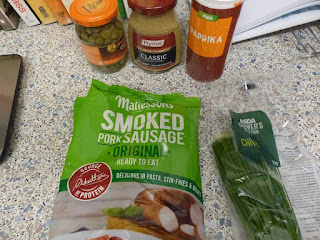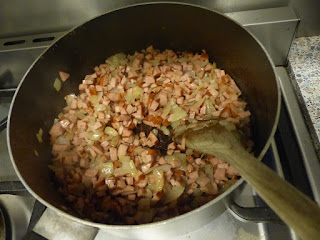◘ THE STARTER ◘
The book: Indian Food Made Easy (Anjum Anand)
The recipe: p80, "Prawn Balchao"
We begin this month with what Anjum Anand describes as "an accompaniment rather than a main dish", making it something I'm happy to co-opt as a starter for Random Menu purposes. There's no photo accompanying the dish, but it seems to be a dry curry that ought to suit being served like a bhuna on a puffed-up puri - a reliable "feels a bit 80s but still dead tasty" Indian restaurant choice as far as I'm concerned.
Prawn Balchao is a Goan dish, so I'm not surprised to learn from Wikipedia that we're missing a diacritic and it should really be the more Portuguese "Balchão". Wiki goes on to explain that this is as much a pickle as it is a curry in its own right, and indeed Anjum herself describes it as "how those living on the southern coast take advantage of the fresh, seasonal and cheap prawns that come their way before the monsoons set in and their supply run dry". As you're probably starting to gather, there's a lot of context for this recipe - so much so that the blurb is longer than the method. Which at least suggests it'll be simple enough to make!
I start by making a paste out of some ginger, garlic, dried mild red chillies (a misreading means I'm using fresh ones, but it doesn't really matter) and a whole load of spices - cloves, peppercorns, cumin seeds, mustard seeds, turmeric - plus a splash or two of water.
 |
| Appetising start |
Next, I heat some vegetable oil in a saucepan before frying a chopped onion until golden brown. Meanwhile, I prepare two medium tomatoes and a green chilli...
 |
| Not like that, you child |
...and add them to the onion, frying for 10-12 minutes "until the mixture becomes a deep burgundy colour".
Attempts to document this colour prove initially unfruitful.
 |
| This is the standard of photography you come here for |
But eventually we get to something acceptable and, I guess, approaching burgundy in colour?
(For the eagle-eyed among you, yes, there is an extra chopped red chilli in there - I decided I'd been a bit stingy on the chilli front when making the paste, Anjum having given me some wiggle room in the shape of the phrase "depending on your tolerance".)
After this, the spice paste goes into the pan too and is fried for another five minutes "until the oil leaves the masala". I'm not sure this ever really happens (or indeed exactly what it means), but I give it five minutes anyway before adding some sugar, some salt... and several tablespoons of malt vinegar. So this is where the "tangy" part of the recipe comes in. It's certainly potent on the nose, and remains so even after the prawns are added and the whole thing is cooked for a couple more minutes until done.
 |
| Prawns in a pickle |
Inevitably, it's not the most attractive dish - throwing in some coriander or curry leaves would have helped in that respect - but it looks and smells pretty promising to me.
Despite what I said earlier about serving it with a bread as a starter, I actually end up using it as part of a curry main meal instead. (I realise this also breaches the Random Menu ethos somewhat. I'll be handing out refunds at our front gate; form a socially distanced queue.) This makes the visual presentation even less impressive - is there any elegant way of plating up curries and rice if you don't own a thali set? - but it does at least allow me to use the Prawn Balchao as an accompaniment and a pickle, just like the recipe suggested.
 |
| The height of style |
And hoo boy, in that role it is good. Exactly as the recipe promised, in fact - spicy, sharp, and full of flavour. It probably would be all right on its own as I originally envisaged, but paired with a slightly milder main, rice and bread, it's an excellent team player and, frankly, the highlight of the plate. "The gravy is moist and clings to the prawns as an envelope of flavour", apparently. There's certainly plenty inside that envelope, anyway.
If I were making it as a curry in its own right, I'd probably use king prawns to make it feel a bit more substantial - and indeed a Google image search for Prawn Balchao suggests that I'm not the only person to feel that way. But "small" prawns are what's called for in the context of a pickle-slash-accompaniment, and this is spot on. I will definitely be making it again (by which I mean I'll forget all about it until I stumble across this blog post in three years' time and think "oh yeah, that").
◘ THE MAIN COURSE ◘
The book: The Little Swedish Kitchen (Rachel Khoo)
The recipe: p122, "Korv Stroganoff" (Smoked Sausage Stroganoff)
We didn't get off to a great start with this book, and you'll be pleased to hear that Rachel Khoo's "changing perfectly good Swedish recipes for no reason" tendencies make themselves known right from the start here, too.
As she says in the introduction, this smoked sausage stroganoff is a Swedish comfort food classic - the kind of thing you'll encounter at home or in a workplace canteen, but hardly the stuff of high-end restaurants. As such, she seems to feel the need to put her own stamp on it by making a couple of basic tweaks to the recipe and serving the thing with pasta instead of the usual rice.
Fine. Okay. I'll try to be open-minded and withhold my wrath (for now).
The sausage that's central to the dish is typically a classic Swedish falukorv. I haven't done a Scandinavian Kitchen order since the back end of the first lockdown, when the initial hoarding instinct slowly gave way to that need to find something to treat ourselves with even when we weren't actually allowed back on trains yet. (I mean, personally I consider stocking up on Bilar and Kalles Kaviar and Leksands Knäcke to be a very essential journey, but I suspect the law would view things differently.)
So we're not going to be getting falukorv today, but having used it extensively over the years in one of those "even you should be able to manage this" dishes my mother armed me with when I left for university - a "Hungarian" sausage sauté that's probably nothing of the sort, it just has paprika in it - I can testify that the trusty Mattessons smoked pork sausage you get in every British supermarket is a pretty decent substitute and I'm happy to go with that here.
Other minor compromises I'm having to make: a medium-strength Polish mustard (actually not too far from its Swedish counterparts flavour-wise) instead of the Dijon called for in the recipe; and regular capers, which the recipe permits as an alternative to its preferred "eldercapers" (basically pickled elderberries, which: nope, not likely). Otherwise it's all mercifully standard stuff.
I begin by bringing a pot of salted water to the boil; it's later going to be used to cook some tagliatelle, though apparently pappardelle would work just as well too. (If I were already committing Swedish culinary sacrilege by using pasta instead of rice, I would reel it in when it comes to being picky about the pasta required, but there we go.)
Meanwhile, I take that pile of smoked sausage and dice it "very finely" before frying it with an chopped onion in plenty of butter. This is another of those deviations from the usual Korv Stroganoff approach - as with the Prawn Balchao, a Google image search clearly shows that fairly big chunks or strips of sausage are typically used. The dicing is fiddly and time-consuming - as an all too relevant point of reference, it takes about as long as a big pan of pasta water needs to come to the boil - but as the cooking process continues, I start to appreciate the benefits of doing it this way: more sausage surface area coming into contact with the butter and heat means more browning and more flavour.
Once I'm happy with how "golden" everything is, I add some tomato purée, mustard, paprika and single cream, stir it all together and let it simmer - on a very low heat, or else it'll burn - for a further five minutes while the pasta is cooking.
I'm terrified of absent-mindedly messing up the next step, which involves reserving a "small mugful" of the pasta water while draining it, but mercifully I remember and all is well. (A small mugful, incidentally, is described as "around 80ml". Bloody small mug, that.)
The pasta water is added to the sausage sauce - or more accurately, the pasta water is what makes it a sauce, as previously it was just some rapidly drying sausage in the bottom of a pan - then two tablespoons of capers are stirred through and it's time to plate up!
For once, my preferred method of just chucking everything together in a pan even if that makes it look horrible is what I'm actually supposed to do. Hurrah! So I toss the sauce through the pasta until it's all well coated, I sprinkle over a "handful" of chopped chives, and we're ready to eat.
As predictably unphotogenic as the results are, there's no denying the taste here. The tiny sausage pieces were a pain in the arse to prepare, but they give the whole thing a deeper flavour than it would have had otherwise, and using a mixture of cream and starchy water for the sauce means it's less cloyingly rich than it might have been.
Even the capers or "eldercapers" - neither of which feature in a standard Korv Stroganoff recipe - win me over, and I find myself grudgingly admitting that adding something tangy to cut through the more comforting flavours is a good call.
The recipe says that this "serves 4", which usually means there'll be just about enough for the two of us - but no, we even end up with a reasonable quantity of leftovers for once.
And like a lot of good comfort food, it's possibly even better second time around as a quick microwave lunch. Giant bra!
One-word verdict: Hearty.
◘ THE DESSERT ◘
The book: How To Cheat At Cooking (Delia Smith)
The recipe: p235, "Cheats' Eton Mess"
It would be far too easy to begin this section with a wry comment about how we're all living in an Eton Mess nowadays...
...so I won't.
Anyway, we remember "How To Cheat At Cooking", right? It's where Delia Smith makes shortcuts to classic recipes that aren't really much of a shortcut and that make the recipe a little bit less good than it ought to be in exchange for no real benefit.
Not that I'm foreshadowing anything here.
It may not be summer yet, but the clocks have gone forward and the weather is showing distinct signs of turning, so that's a good enough excuse for a berry simple dessert. And Eton Mess is always a favourite - although surely it's not so difficult to make that it requires significant corner-cutting?
Delia's cheats this time: using Greek yoghurt instead of whipping up some cream (certainly a time-saver, definitely an indulgence downgrade), and using pre-made meringue nests instead of making your own. I'll be honest, Delia - I wouldn't do the meringues from scratch even if I was making a non-cheats' Eton Mess, and not just because I have history with the genre.
Anyway, this does make for a delightfully simple ingredient line-up:
And we begin by [checks notes]... oh. By taking half of those strawberries and puréeing them with a spoonful of icing sugar, apparently. That seems a little off-piste, but okay.
 |
| Yum |
That done, we enter more familiar territory: The meringue nests are broken up "into small pieces" in a large mixing bowl, the rest of the (halved) strawberries are added and the yoghurt is folded through.
Next, Delia wants me to take most of the strawberry purée and carefully fold it through the mixture "to give a sort of marbled effect".
 |
| A little less "marbled", a little more "bloodied" |
So yeah, that's not a massive success. No matter how carefully I fold it, the purée starts blending with the yoghurt (it's full-fat, I didn't make that mistake this time), and I'm quickly left with a bowl full of what I can only describe as off-pink mush.
In fact, I don't really see how you'd escape the sloppiness factor here - using yoghurt instead of whipped cream and adding a load of berry juice all but guarantees it. What's more confusing is the photo accompanying the recipe shows no signs of purée, marbled or otherwise, just some strawberries resting on a couple of meringue chunks and a glob of unsullied white yoghurt. So even the publisher's design team clearly thought this was a stupid idea.
Oh well, time to plate up and make the best of it, anyway.
Yep - it's already basically disintegrated into one big old bowlful of mush, not helped by the requirement that the rest of the purée be spooned (not even "drizzled") on top. Lovely.
It eats fairly well - it's sugar in various forms, how wrong can it be? - but the liquid content from the yoghurt and fruit makes it feel more like an Eton Mess-flavoured smoothie with lumps in it than a dessert-time treat.
Not especially authentic, not all that much of a time-saver, not Delia's finest moment.










No comments:
Post a Comment